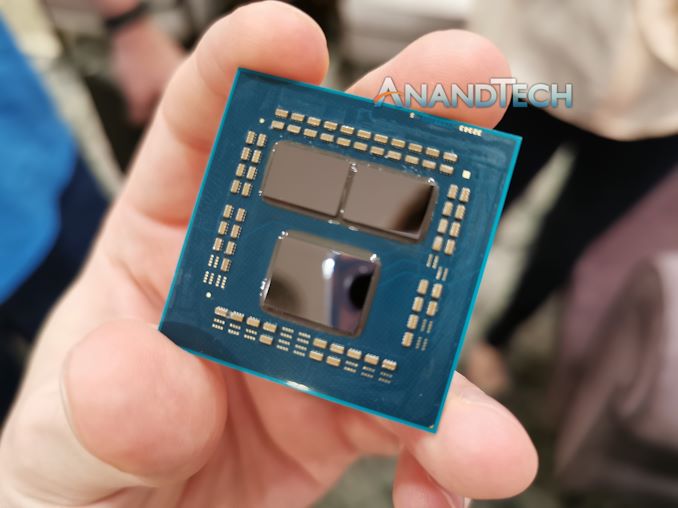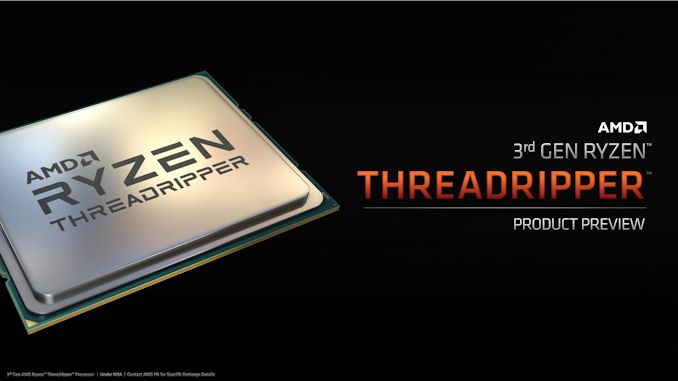AMD Q4: 16-core Ryzen 9 3950X, Threadripper Up To 32-Core 3970X, Coming November 25th
by Dr. Ian Cutress on November 7, 2019 9:00 AM EST
AMD is set to close out the year on a high note. As promised, the company will be delivering its latest 16-core Ryzen 9 3950X processor, built with two 7nm TSMC chiplets, to the consumer platform for $749. Not only this, but AMD today has lifted the covers on its next generation Threadripper platform, which includes Zen 2-based chiplets, a new socket, and an astounding 4x increase in CPU-to-chipset bandwidth.
This year AMD is presenting its ‘Fall 2019 Desktop Update’, covering the new products for the holiday season. Q4 is historically a good target for increased consumer sales, as long as the products hit the right price point and are available in volume for the peak shopping periods. We’ve been waiting mercilessly for more details about the crème-de-la-crème of what AMD has to offer with its 7nm product portfolio for both mainstream Ryzen desktop processors, but also the creator and workstation focused 3rd Gen Threadripper. After continuously requesting information from CEO Lisa Su since the middle of the year, AMD is lifting the lid on the product details, pricing, and launch dates.
The short version of today’s announcement revolves around several parts, in completely different markets.
- The Ryzen 9 3950X 16-core CPU for desktops
- Ryzen Threadripper 3rd Gen Family: Starting with the 24-core 3960X and 32-core 3970X
- New TRX40 motherboards for the new Threadripper Processors
- A new $49 Athlon 3000G for the entry level market
All of this hardware is set to come to market through the month of November at the following dates:
- Ryzen 9 3950X: Retail on November 25
- TR 3960X and TR 3970X on November 25th
- TRX40 motherboards on November 25th
- Athlon 3000G on November 19th
One key takeaway from today’s announcements is how AMD is moving the traditional desktop and high-end desktop markets. When CEO Dr. Lisa Su was asked earlier this year what will happen to Threadripper as the mainstream Ryzen family moves ‘up’ in performance, her response was that ‘Threadripper will move up-up’. To that effect, we are seeing AMD’s delineation between mainstream desktop and high-end desktop move up to between 16-core and 24-core, with room at the top for more cores if AMD wants to go that way.

Our Group Interview with Dr. Lisa Su at Computex 2019
This new hardware is also breaking new records for enthusiast CPU TDP values, as well as representing new ground on the latest 7nm process technology now available to the wider market. Details about pricing, TDP, AMD’s strategy, AMD’s performance numbers, TRX40 chipset information, and analysis of the announcements are all inside.












171 Comments
View All Comments
Total Meltdowner - Thursday, November 7, 2019 - link
I've done it like twice. That's pretty good, though. May do it again here with the 3700x if the price drops a bit. Will replace my 1800x.proflogic - Thursday, November 7, 2019 - link
That moving line for HEDT is kind of lame. Now it costs even more to get more memory channels and/or PCIe lanes.Are core counts increasing to nonsense levels on AM4? Can they even be served well with the amount of I/O and memory throughput available to them?
Spunjji - Friday, November 8, 2019 - link
Not really. A little more, but not a lot more.The answer to your question can be found on this site. The short answer is: yes.
The long answer is: some tasks benefit from more memory bandwidth, but only if they're bound by that limitation in the first place. They're the sort of tasks you'd only do on a HEDT platform in the first place.
WaltC - Thursday, November 7, 2019 - link
Nice write up! It's interesting to watch Intel drop further and further behind. 2020 should be a blowout year for AMD. Surprising that anyone is still buying Intel's old, massively security-hole-punched architectures, made on the old 14nm process, to boot. Processing performance, not MHz, has been the name-of-the-game since 1999. Hard to believe that in 2019 there are people who still don't understand what that means...;) I always thought it was rather elementary.imaheadcase - Thursday, November 7, 2019 - link
Umm, considering holes was fixed, and 14nm process means nothing to end users they are doing good. Intel is still a great CPU, it makes sense for lots of people. Upgrade path to AMD is not exactly cheap if you already have intel cpu..you got to get new mobo/ram as added cost to going amd.Mhz is still king for flat game performance as well.
Sounds like you are just a uninformed on how things actually work in the real world.
Korguz - Thursday, November 7, 2019 - link
" Mhz is still king for flat game performance as well. " not really.. ipc is also just as important.and right now, clock for clock, amd wins there. for the most part, ryzen is pretty close to intel even with the clock speed disadvantage... imagine if ryzen were at the same clocks as intel...milkywayer - Thursday, November 7, 2019 - link
Yup because we should all cpu buying decisions based on what cpu offers an extra frame or two when most games on almost all mod tier cpus can do 75 to 100fps.14nm is ancient and Intel is milking it thanks to fangirls who were happily buying dual core i7s on mobile until AMD came in and kicked them in the rear and finally made 6 core cpus the new low tier norm.
Count Rushmore - Thursday, November 7, 2019 - link
Don't be harsh... according to them, human eyes can only see 4 cores & PC is for gaming only. All Those multi-billions $ games apparently developed exclusively on i7 procskgardas - Thursday, November 7, 2019 - link
"Umm, considering holes was fixed," -- are you sure? To me it looks like Intel still sell more CPUs with holes not fixed (in silicon) than those fixed. Honestly Intel message about this is all big mess...haukionkannel - Friday, November 8, 2019 - link
It is all about pricing! Intel has huge r&d and their cpus Are really good, if the price is ok!